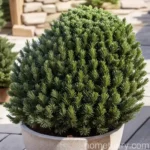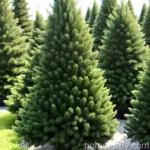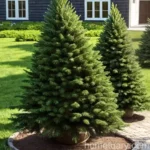Understanding the Norway Spruce (Picea abies ‘Witch’s Brood’)
What is a Plant: Norway Spruce (Picea abies ‘Witch’s Brood’)
Plants are essential to life on Earth. They are a diverse group of organisms that belong to the kingdom Plantae. These organisms vary from ferns, mosses, and algae to the more complex flowering plants. They are vital for human survival, as they provide oxygen, food, and habitat for numerous organisms. In this blog post, our focus is on the Norway spruce (Picea abies ‘Witch’s Brood’).
Norway spruce is a popular tree in horticulture due to its evergreen nature, aesthetic appeal, and various uses. The ‘Witch’s Brood’ cultivar is particularly fascinating due to its unique growth patterns and features, making it an increasingly sought-after addition to gardens and landscapes.
Key Takeaways – Norway Spruce (Picea abies ‘Witch’s Brood’)
Before delving into the specifics of caring for and understanding the Norway spruce (Picea abies ‘Witch’s Brood’), let’s explore some key takeaways about this fascinating plant:
- The ‘Witch’s Brood’ is a captivating cultivar of the Norway spruce, characterized by its unique growth habits and features.
- This variety is highly adaptable and can be used in diverse landscape designs.
- It requires adequate sunlight, well-drained soil, and moderate watering to thrive.
Now, let’s explore the various aspects of cultivating, caring for, and appreciating the Norway spruce (Picea abies ‘Witch’s Brood’).
Culture
Cultivating the Norway spruce (Picea abies ‘Witch’s Brood’) requires an understanding of its specific cultural requirements to ensure optimal growth and health. Let’s explore some key cultural considerations:
Water
Proper watering is crucial for the health of the Norway spruce, especially during its establishment phase. Here are some important points to consider:
-
Young Trees: Newly planted Norway spruce trees require consistent watering, especially during dry periods, to support root development. Ensure that the soil is evenly moist but not waterlogged.
-
Mature Trees: Once established, mature Norway spruce trees generally have good drought tolerance. However, during prolonged dry spells, it’s essential to provide supplemental watering to maintain their vigor and overall health.
Sunlight
Norway spruce trees thrive in full sun to partial shade. When selecting a location for planting, consider the following:
-
Full Sun: Provide at least six hours of direct sunlight daily for robust growth and development.
-
Partial Shade: While tolerant of partial shade, ensure that the tree receives adequate sunlight for healthy growth and optimal needle density.
Fertilizer
Fertilization plays a crucial role in enhancing the growth and vitality of Norway spruce trees. Consider the following guidelines:
-
Timing: Apply a balanced, slow-release fertilizer in early spring before the onset of new growth to provide essential nutrients for the upcoming growing season.
-
Application: Spread the fertilizer evenly over the root zone, avoiding direct contact with the trunk, and water thoroughly to facilitate nutrient uptake.
Soil
The Norway spruce (Picea abies ‘Witch’s Brood’) thrives in well-drained, slightly acidic soils. Consider the following soil requirements:
-
Drainage: Ensure that the planting site has good drainage to prevent waterlogging, which can lead to root rot and other issues.
-
Soil pH: Ideally, the soil should have a pH range of 5.0 to 6.5, indicating slightly acidic conditions that are favorable for the tree’s growth.
Pruning
Pruning is an essential aspect of Norway spruce tree care, contributing to its aesthetic appeal and overall health. Consider the following pruning guidelines:
-
Timing: Prune Norway spruce trees in late winter or early spring before new growth emerges.
-
Techniques: Remove dead or diseased branches, and shape the tree as desired while avoiding excessive pruning, which can impact the tree’s natural form.
Uses
The Norway spruce (Picea abies ‘Witch’s Brood’) offers a range of uses, making it a versatile and valuable addition to landscapes and gardens. Let’s explore its various applications:
-
Ornamental: The ‘Witch’s Brood’ cultivar’s unique growth habits and aesthetic appeal make it an excellent choice for ornamental planting, adding visual interest to landscapes and gardens.
-
Windbreaks: Due to its dense foliage and conical shape, Norway spruce is often used as a windbreak to provide protection from harsh winds.
-
Timber: In commercial forestry, Norway spruce is a valuable source of timber used in construction, furniture making, and other wood-based industries.
Propagation
The propagation of the Norway spruce (Picea abies ‘Witch’s Brood’) can be achieved through various methods, including:
Seed Propagation
- Collect mature cones from the tree and extract the seeds.
- Sow the seeds in a seedbed or containers filled with well-draining, sterile potting mix.
- Provide adequate moisture and keep the seeds in a sheltered location until they germinate.
Cuttings
- Take semi-hardwood cuttings from the current season’s growth in late summer.
- Dip the cut ends in rooting hormone and plant them in a suitable growing medium.
- Maintain high humidity and consistent moisture to support root development.
Container Popularity
The ‘Witch’s Brood’ cultivar of the Norway spruce is increasingly popular for container planting, offering versatility and aesthetic appeal in various settings. Consider the following points regarding its container popularity:
-
Urban Landscapes: The compact size and unique growth patterns of the ‘Witch’s Brood’ make it well-suited for urban landscaping, including public spaces and private gardens.
-
Patio Gardens: Its adaptability to container planting makes it an attractive choice for patio gardens and small outdoor spaces, adding a touch of greenery and visual interest.
Container Common Diseases
When cultivating Norway spruce (Picea abies ‘Witch’s Brood’) in containers, it’s essential to be aware of potential diseases that may affect the tree. Common container diseases include:
-
Root Rot: Overly moist or waterlogged soil can lead to root rot, causing decline and wilting in the tree.
-
Needle Cast: Fungal diseases such as Rhizosphaera needle cast can affect the tree’s needles, leading to discoloration and premature shedding.
Disease Diagnosis
If you notice any signs of disease or decline in the ‘Witch’s Brood’ cultivar, promptly diagnose the issue and take appropriate measures to address it. Consider the following steps for disease diagnosis:
-
Visual Inspection: Examine the tree for visible symptoms such as discolored needles, stunted growth, or wilting.
-
Consultation: Seek advice from a plant health professional or horticulturist to accurately diagnose the issue and recommend suitable treatment options.
Common Pests
Pests can pose a threat to the health and vitality of Norway spruce trees, including the ‘Witch’s Brood’ cultivar. Common pests to watch out for include:
-
Spruce Budworm: The larvae of spruce budworm moths can cause significant damage to new growth by feeding on the buds and needles.
-
Adelgids: These tiny insects can infest spruce trees, causing needle discoloration and affecting overall tree health.
Botanist’s Tips
As a plant scientist, I would like to offer some valuable tips for successfully cultivating and appreciating the Norway spruce (Picea abies ‘Witch’s Brood’):
-
Site Selection: Choose a planting site with well-drained soil and ample sunlight to promote healthy growth.
-
Maintenance: Regularly inspect the tree for signs of pests, diseases, or nutrient deficiencies, and take proactive measures to address any issues.
-
Pruning Practices: Practice minimal but strategic pruning to maintain the tree’s natural form while removing any dead or damaged branches.
-
Soil Management: Monitor soil moisture and ensure proper drainage to prevent conditions conducive to root rot and other soil-borne issues.
Fun Facts
To further appreciate the unique qualities of the Norway spruce (Picea abies ‘Witch’s Brood’), consider the following fun and intriguing facts:
- The Norway spruce is the tallest native tree in Europe, known for reaching impressive heights in its natural habitat.
- It has been widely planted in North America for over 200 years and has become a staple of traditional Christmas tree decorations.
Links to External Resources
For further information about the Norway spruce (Picea abies ‘Witch’s Brood’), its care, and various uses, consider exploring the following external resources:
- The Spruce – Norway Spruce Trees: Facts and Growing Tips
- Royal Horticultural Society – Picea abies ‘Witch’s Brood’
- University of Florida IFAS Extension – Norway Spruce (Picea abies)
In conclusion, the Norway spruce (Picea abies ‘Witch’s Brood’) stands as a captivating and versatile addition to gardens, landscapes, and urban environments. Understanding its specific cultural needs, propagation methods, and potential challenges contributes to successful cultivation and appreciation of this remarkable tree.
By incorporating the insights and guidelines shared in this blog post, enthusiasts and horticulturalists can foster the health and vitality of the ‘Witch’s Brood’ cultivar, enhancing the beauty and ecological value of their surroundings.
Keywords: Norway spruce plant, Witch’s Brood Norway spruce, Picea abies Witch’s Brood, Witch’s Brood spruce tree, Norway spruce variety, Witch’s Brood conifer, Picea abies cultivar, Witch’s Brood spruce species, Norway spruce Witch’s Brood characteristics, Witch’s Brood spruce care, Picea abies Witch’s Brood information, Witch’s Brood spruce growth habits, Norway spruce Witch’s Brood pruning, Witch’s Brood spruce landscape, Picea abies Witch’s Brood propagation, Witch’s Brood spruce pests and diseases, Norway spruce Witch’s Brood planting, Witch’s Brood spruce maintenance, Picea abies Witch’s Brood landscaping, Witch’s Brood spruce fertilizer requirements, Norway spruce Witch’s Brood size, Witch’s Brood spruce shade tolerance, Picea abies Witch’s Brood drought tolerance, Witch’s Brood spruce winter hardiness, Norway spruce Witch’s Brood medicinal uses, Witch’s Brood spruce forest ecosystem, Picea abies Witch’s Brood wildlife habitat, Witch’s Brood spruce timber uses, Norway spruce Witch’s Brood ornamental value, Witch’s Brood spruce aromatic properties, Picea abies Witch’s Brood wood density, Witch’s Brood spruce natural range, Norway spruce Witch’s Brood evergreen features, Witch’s Brood spruce needle retention, Picea abies Witch’s Brood landscape design, Witch’s Brood spruce windbreak benefits, Norway spruce Witch’s Brood horticultural uses, Witch’s Brood spruce bonsai cultivation, Picea abies Witch’s Brood holiday decoration, Witch’s Brood spruce seed collection, Norway spruce Witch’s Brood seedling care, Witch’s Brood spruce climate requirements, Picea abies Witch’s Brood common problems, Witch’s Brood spruce environmental impact, Norway spruce Witch’s Brood urban planting, Witch’s Brood spruce wind and salt tolerance, Picea abies Witch’s Brood garden design, Witch’s Brood spruce natural repellents, Norway spruce Witch’s Brood companion plants, Witch’s Brood spruce landscape architecture















